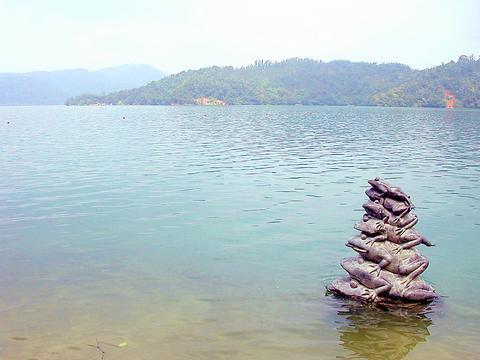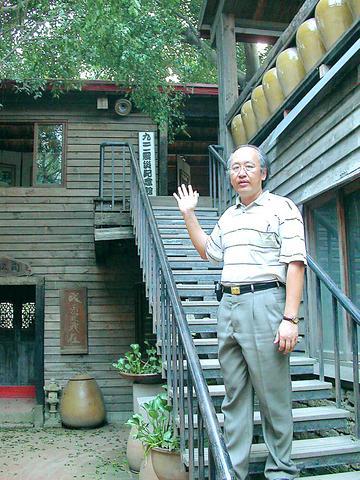Four years after the 921 earthquake, one of the most traumatic incidents in its history, Sun Moon Lake (
A record-breaking number of tourist visited the the lake in the past year, drawn to the new attractions set up after the quake.
Except for the few reconstruction sites of hotels razed in the quake, you won't even notice this vibrant tourist spot was defaced four years ago.

PHOTO: VICO LEE, TAIPEI TIMES
In the early morning of this day in 1999, an earthquake measuring 7.3 on the Richter scale shook the entire country. Its epicenter was 7.5km underground and 6.5km southwest of Sun Moon Lake. Over 2,300 people were killed and 39 went missing across Taiwan. Around Sun Moon Lake, large hotels crumbled. Wen Wu Temple (
Fortunately, Sun Moon Lake itself was undamaged and kept its former appearance and almost all facilities that were affected were restored by the end of last year, according to the Sun Moon Lake National Scenery Bureau. Four months after 921, the 1,900 hectare Sun Moon Lake Scenery Park was extended and it is now the 9,000 hectare Sun Moon Lake National Scenery Park. Administration for the park was transferred from the Nantou County Government to the Ministry of Transportation and Communication's Tourism Bureau.
When the Wen Wu Temple, the last lake-side reconstruction to be finished, reopens today, Sun Moon Lake will have won back all it has lost. Attractions set up after the earthquake, such as the eight lake-side foot-paths and bicycle tracks, add to the park's appeal.

PHOTO: VICO LEE, TAIPEI TIMES
A total of NT$1.368 billion has been poured into reconstruction in the past four years. "Work done in the past four years is much more than that done by the Nantou County Government in the 10 years before 921. The county government used to maintain what was already there, but since Sun Moon Lake became a national scenic area, there are new constructions we would never have expected before," said a life-long resident surnamed Huang. who lives in Shui-she (
In contrast with the many gloomy post-quake reports of Sun Moon Lake's future, residents now look back on the disaster in a more positive light. "In the quake, the worse hit was the hotels and Kuanghua Islet. The lake was what it was all along, just very beautiful," said Deng Hsiang-yang (鄧相揚), chief executive of the Sun Moon Lake Tourism Development Association, an organization of businesses in the area.
According to the Tourism Bureau, between 600,000 and 700,000 people visited the lake every year from 1998. In 1999, the year of the 921 earthquake, there were 630,000 visitors. The number dwindled to 310,000 in 2000, increased to 500,000 in 2001 and went back to the former level in last year, with 670,000 visitors. This year's numbers have already exceeded that, thanks to the first Sun Moon Lake International Fireworks Festival (日月潭國際水上花火嘉年華 ) and Sun Moon Lake Lake-Shore Music and Dance Festival (日月潭湖畔音樂舞蹈藝術節 ), which have brought in a daily average of 60,000 tourists. The Scenery Bureau expects the number of visitors to exceed 1 million this year.
Most hotel and tourist spot operators agreed that business has got back to normal, or is even better than normal this year. They attributed the improvement to the enlargement of the scenery park, now stretching from Yu-che (魚池) Township on the North, Shui-she (水社) on the East and Shui-li (水里) on the South to include Shui-li Snake Kiln (水里蛇窯 ), the Formosan Aboriginal Culture Village (九族文化村), Chi-chi Mountain (集集大山), Che-cheng's (車埕) and Da-kuan Power Plant (大觀電廠).
After tourism was affected by SARS from March through June, the Formosan Aboriginal Culture Village promoted tourism with a 50 percent discount, bringing in crowds of students in the summer vacation. Some of these have spread into the lake-side area.
"Tourist flows to Sun Moon Lake are very susceptible to influences. Promotion activities of any kind easily brings in tourists to other spots as well," Deng said.
Lin Su-chen (
"Many people are curious to see how Puli and Sun Moon Lake have changed after 921. All these tourists have to pass by my restaurant, so I was willing to invest the money," Lin said. "There's a saying that goes, `There is no great construction without severe destruction before it,' so the
disaster has its positive
consequences."
Lin Kuo-long (林國隆), owner of Shui-li Snake Kiln, one of the worst hit tourist spots, said the Sun Moon Lake area gained more from the earthquake than it had lost.
"The earthquake seriously affected business for roughly one year and after that it's been a series of national-level constructions and an increased budget, which will last a long time," Lin said. The kiln will soon see a new transportation hub built at its gate, which Lin expected to bring in more business.
Lin's optimism is backed up by the long history of the kiln, which had survived numerous typhoons, other earthquakes and SARS-induced recession.
"The earthquake of 921 was one of the various natural disasters the kiln has weathered. As long as the highway is working, people will come," Lin said.
Financial assistance from the government has also encouraged businesses to try new things. For instance, now Sun Moon Lake can boast one of the popular high-end holiday hotel/spa resorts, The Lalu (
The return of tourists has also brought back those who depend on them.
"If there's a major change in the Sun Moon Lake area this year, it's that tourists are back, and the hard-selling peddlers are back with them," resident Huang said.

In the March 9 edition of the Taipei Times a piece by Ninon Godefroy ran with the headine “The quiet, gentle rhythm of Taiwan.” It started with the line “Taiwan is a small, humble place. There is no Eiffel Tower, no pyramids — no singular attraction that draws the world’s attention.” I laughed out loud at that. This was out of no disrespect for the author or the piece, which made some interesting analogies and good points about how both Din Tai Fung’s and Taiwan Semiconductor Manufacturing Co’s (TSMC, 台積電) meticulous attention to detail and quality are not quite up to

April 21 to April 27 Hsieh Er’s (謝娥) political fortunes were rising fast after she got out of jail and joined the Chinese Nationalist Party (KMT) in December 1945. Not only did she hold key positions in various committees, she was elected the only woman on the Taipei City Council and headed to Nanjing in 1946 as the sole Taiwanese female representative to the National Constituent Assembly. With the support of first lady Soong May-ling (宋美齡), she started the Taipei Women’s Association and Taiwan Provincial Women’s Association, where she

It is one of the more remarkable facts of Taiwan history that it was never occupied or claimed by any of the numerous kingdoms of southern China — Han or otherwise — that lay just across the water from it. None of their brilliant ministers ever discovered that Taiwan was a “core interest” of the state whose annexation was “inevitable.” As Paul Kua notes in an excellent monograph laying out how the Portuguese gave Taiwan the name “Formosa,” the first Europeans to express an interest in occupying Taiwan were the Spanish. Tonio Andrade in his seminal work, How Taiwan Became Chinese,

Mongolian influencer Anudari Daarya looks effortlessly glamorous and carefree in her social media posts — but the classically trained pianist’s road to acceptance as a transgender artist has been anything but easy. She is one of a growing number of Mongolian LGBTQ youth challenging stereotypes and fighting for acceptance through media representation in the socially conservative country. LGBTQ Mongolians often hide their identities from their employers and colleagues for fear of discrimination, with a survey by the non-profit LGBT Centre Mongolia showing that only 20 percent of people felt comfortable coming out at work. Daarya, 25, said she has faced discrimination since she